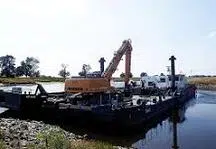Before entering fully into the meaning of the term dredge, we are going to proceed to know its etymological origin. In this case, we can point out that it is a word that derives from French, exactly from “drague”, which can be translated as “net”.
The verb dredge refers to the use of a dredge to clean and deepen a river, lake, canal or other body of water. The dredge, for its part, is the machine that allows this task to be carried out by extracting rocks, sand and other materials and sediments.
 By dredging, it is possible to increase the depth of a waterway . In this way, navigation is facilitated, allowing large vessels to move without the risk of running aground. That is why these tasks are necessary in ports : if they intend to receive huge cruise ships, for example, dredging is likely to be required.
By dredging, it is possible to increase the depth of a waterway . In this way, navigation is facilitated, allowing large vessels to move without the risk of running aground. That is why these tasks are necessary in ports : if they intend to receive huge cruise ships, for example, dredging is likely to be required.
Dredging, on the other hand, provides greater water transfer capacity to the road in question. This minimizes the possibility of flooding in the surrounding areas.
There are different types of dredges according to the characteristics of the terrain to be dredged. Some of these machines are installed on land , while others operate from boats .
What is done when dredging is excavating material that is submerged, extracting it and bringing it to the surface. This action results in an increase in the depth of the body of water and a decrease in its level.
Among the mechanical dredgers , there are excavator dredgers , front-loading shovel dredgers , continuous hopper dredgers and bucket dredgers . In the group of suction dredgers , on the other hand, we can find running suction dredgers , stationary suction dredgers and cutter dredgers .
It is interesting to establish, in addition to everything indicated, that the dredge was a machine that the great genius Leonardo da Vinci was responsible for designing. Specifically, it responded to the name of lagoon dredge and was an excavator in charge of cleaning the bottom of certain channels.
Its operation and principle was similar to that of the dredgers that exist today and was based on the use of a series of buckets that acted one after the other and that, while digging, allowed the dirt and collected material to be stored in some devices that responded to the name of storage floats.
Nowadays, a model of this type of device called the van veen dredge is well known. What this achieves is to obtain samples of surface sediments in medium-hard or soft bottoms. Specifically, it is used very frequently both in biological studies and in others of a hydrological nature and even in those that are framed within the environmental field.
Its appearance is that of two spoons that are connected through a hinge. Those are separated, but they are joined together to collect sediment samples.
